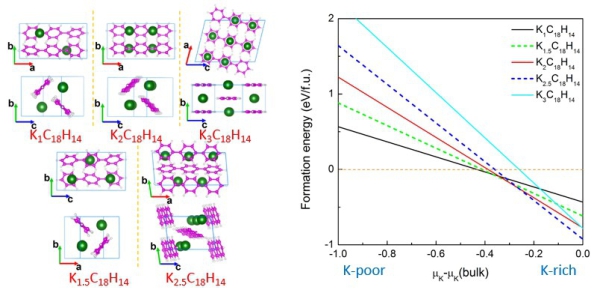Researchers Reveal the Microstructure of Potassium-doped P-terphenyl High-temperature Superconductor
Date:06-03-2018 | 【Print】 【close】
K-doped p-terphenyl (KxC18H14) is new high-temperature superconductor with the critical temperature (Tc) of above 120 K and is a potential room-temperature superconductor. However, the crystal and electronic structures for this novel superconducting phase are still unknown.
Researcher ZHONG Guohua, from Shenzhen Institute of Advanced Technology, Chinese Academy of Sciences, established a microscopic picture of the phase structure of KxC18H14 and revealed the crystal and electronic characteristics of KxC18H14, which is meaningful for understanding this novel superconductivity. The paper “Structural and Bonding Characteristics of Potassium-Doped p‑Terphenyl Superconductors” was published on the Journal of Physical Chemistry C on February 2018.
By using the first-principles method, ZHONG Guohua and his collaborators have systematically investigated the thermodynamic stability, structural, electronic, and magnetic properties of KxC18H14. Combining the formation energy, bonding characteristics, and X-ray diffraction patterns, they determined that the K-doping concentration is constrained to within the range of 2−3. For a small amount of charge transferred, the tilting force between the two successive benzenes drives the system to stabilize at the antiferromagnetic ground state, whereas the system exhibits nonmagnetic behavior with increasing charge transfer. The multiformity of band structures near the Fermi level indicates that the driving force for superconductivity is complicated.
This work was supported by the National Nature Science Foundation of China, the Shenzhen Basic Research Grant and the NSFC-Guangdong Joint Fund.

Fig. The microscopic structures and thermodynamic stability of KxC18H14.
CONTACT:
ZHANG Xiaomin
Email: xm.zhang@siat.ac.cn
Tel: 86-755-86585299